Every so often here at Contrarian Outlook, we get questions from readers about investments sporting yields that are, frankly, ridiculous.
Case in point: The 85% forward yield (as of this writing) on a fund called the YieldMax Ultra Option Income Strategy ETF (NYSE:ULTY): Eighty. Five. Percent.
Think about that for a second: With an 85% yield, you’re getting your entire upfront investment back in about a year. Pretty sweet deal, right?
Well, not so fast.
Before I go further, I should say that when it comes to dividends, one thing we demand at my Contrarian Income Report advisory is that a stock or fund at least “returns its yield.” We target dividends of at least 5%, but usually much more. Our portfolio currently sports yields as high as 14%.
When I say “return its yield,” I mean that we want—at a minimum—the price to remain steady as we collect our high dividends.
ULTY? Well, what its dividend giveth, its share price taketh away—and then some! Since the fund launched a little over a year ago, those who bought off the hop are down 12.4% as of this writing, with dividends included.
Big Dividend Doesn’t Help ULTY Investors
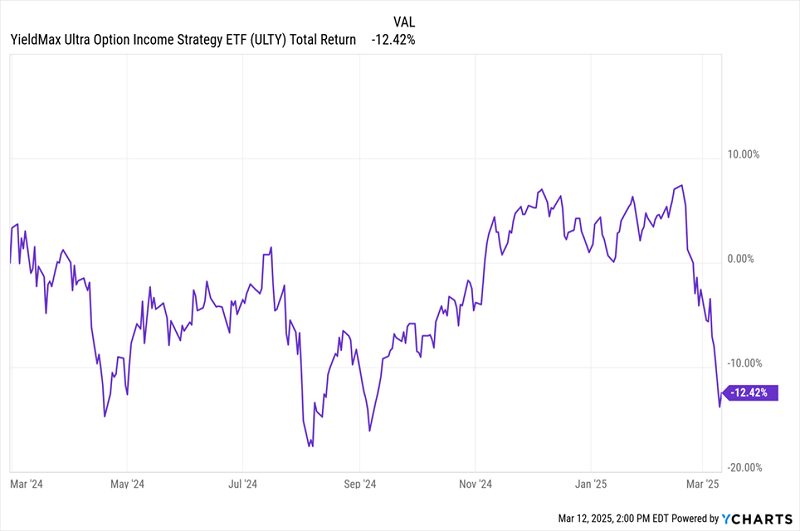
That’s an especially tough pill to swallow in a time when the S&P 500 returned 11%—even with the “tariff terror” we’re living through now. And the right side of that chart pretty much dispels any idea that ULTY’s high dividend can protect you from volatility.
In fact, if you strip out the dividend, the fund has dropped 66% on a price basis alone. That’s one reason for that 85% yield, since yields and prices move in opposite directions.
This performance is especially disappointing because ULTY uses covered calls to generate extra income. By selling covered-call options on its portfolio, for example, the fund sells investors the right to buy its stocks at a fixed date and price in the future. No matter what happens with these trades, ULTY keeps the option “premium” it charges these investors.
It’s a great way for high-yield funds like this to build up their income streams, and it normally works well in volatile markets. The drawback is that it can cap upside as the fund’s best performers are sold, or “called away.”
But the opposite seems to be happening here, with ULTY getting clobbered in the recent volatility. Why?
Let’s look at the strategy. The fund says it has a menu of covered-call strategies that it uses on each of its underlying securities, which typically number from 15 to 30. These strategies are constantly monitored and adjusted if necessary. Plus this portfolio turns over a lot, which adds cost and risk: From ULTY’s launch on February 28, 2024, through October 31, 2024, its turnover rate amounted to 717% of the average value of its portfolio.
So there’s a lot of management required here. And as I write, ULTY is highly focused on volatile tech stocks, with names like trading platform Robinhood Markets (NASDAQ:HOOD), MicroStrategy (NASDAQ:MSTR)—formerly known as MicroStrategy and essentially a levered play on Bitcoin—database supplier MongoDB (NASDAQ:MDB) and crypto exchange Coinbase Global (NASDAQ:COIN) showing up in its top holdings.
These holdings, of course, have been hit hard in the selloff, likely overwhelming any option income brought in. And that’s far from the worst of it, because I think you’ll agree that the fund’s dividend history is the opposite of what we demand. (Very small consolation: Until recently, ULTY paid dividends monthly, but now, according to its website, it appears to be paying weekly, with the last payment coming in at $0.1025 per share.)
A Monthly—or Weekly—Payout Isn’t Much Good if It Shrinks
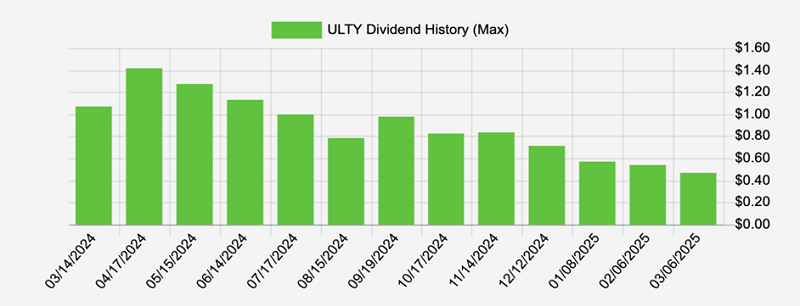
Source: Income Calendar
We’re currently getting that 85% yield by annualizing that $0.1025 payout the fund made on March 14. Since we’d need 52 straight payouts of that size to maintain such a yield at current price levels, I think you’ll agree that this is a mirage, based on the trend we’re seeing here.
Finally, ULTY charges a 1.3% expense ratio—steep for an ETF, especially when you can get much better performance (and income stability) from the fund we’ll talk about next. And you’ll pay its expert managers a tiny fraction—just 19% of ULTY’s fee.
This “Option-Driven” 7% Payout Pops With Volatility
In 2020, Jamie Dimon and his team launched the JPMorgan Equity Premium Income ETF (NYSE:JEPI). The fund has a simple strategy: It buys and holds blue-chip stocks, like current top holdings AbbVie (NYSE:ABBV), Visa (NYSE:V) the Southern Co. (NYSE:SO) and Progressive Corp. (NYSE:PGR), and sells covered-call options on them.
Just from that quick sample alone, you can see that this one is far more diversified than ULTY. They also pay dividends, unlike the vast majority of ULTY’s holdings. Those payouts give the fund a nice “head start” on the 7% yield the fund ultimately pays us.
So let’s break this down a bit further: JEPI takes that 1% to 2% in dividends, “tacks on” a roughly 5% to 8% return in the form of option premiums, then uses any gains in its portfolio to fill out the rest of its return. Here’s how it all comes together: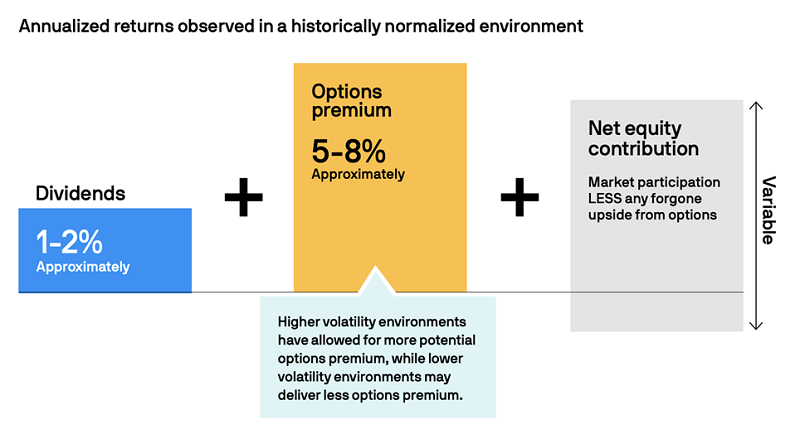
Source: JPMorgan Equity Premium Income ETF December 31 fund story
Plus we’ve got Jamie Dimon and his team running this setup—the portfolio managers at JEPI boast 60 years of experience between them. This is the crew we want selling options for us. And we’re getting their expertise for an expense ratio of just 0.25%.
Now, to be sure, there’s no free lunch here. When the S&P 500 declines, so does JEPI. But the fund’s high yield, diversification and option strategy help put a floor under its price. Look at how JEPI (in purple) has performed year-to-date, as of this writing: It’s essentially flat compared to a 5% drop for the S&P 500 (in orange):
JEPI’s Steady Hand in Uncertain Times
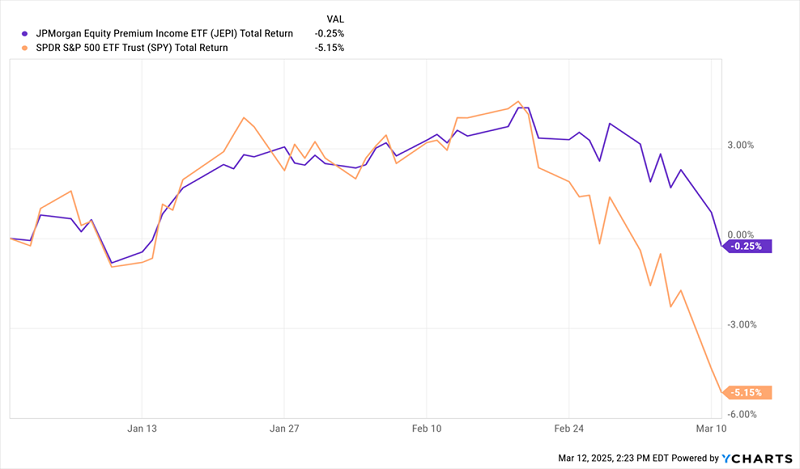
Meantime, investors are underestimating this dividend. They are looking in the rearview mirror instead of out the front dash.
JEPI pays a monthly dividend, and it does vary depending on option income that month. (Dimon’s guys and gals don’t sell assets to smooth it out—the payout is what it is.) Armchair investors lament that JEPI does not pay the same as in 2022. It must be a failed experiment, they cry!
JEPI’s Monthly Dividend Since Inception
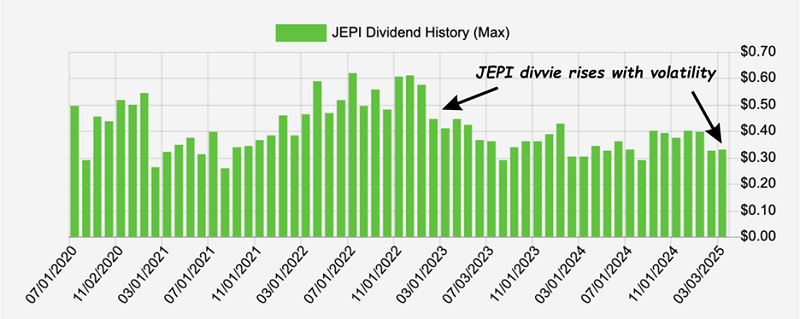
Source: Income Calendar
They are wrong. In 2022, the financial world was falling apart as the Federal Reserve drained liquidity from the system. Volatility was high, which meant options commanded quite the pretty premiums.
Markets calmed down after that, as the Fed engaged in some “Quiet QE,” which resulted in less option-writing income for JEPI. But now that we’re back into a period of wild volatility, I expect that option income—and JEPI’s dividend payouts—to edge higher. We can already see a hint of that on the right side of the chart above.
That makes this dip a great time to buy JEPI. ULTY? Its share price and its dividend are both “falling knives.” Its near-100% yield is a danger sign, not a benefit.
Disclosure: Brett Owens and Michael Foster are contrarian income investors who look for undervalued stocks/funds across the U.S. markets. Click here to learn how to profit from their strategies in the latest report, "7 Great Dividend Growth Stocks for a Secure Retirement."
